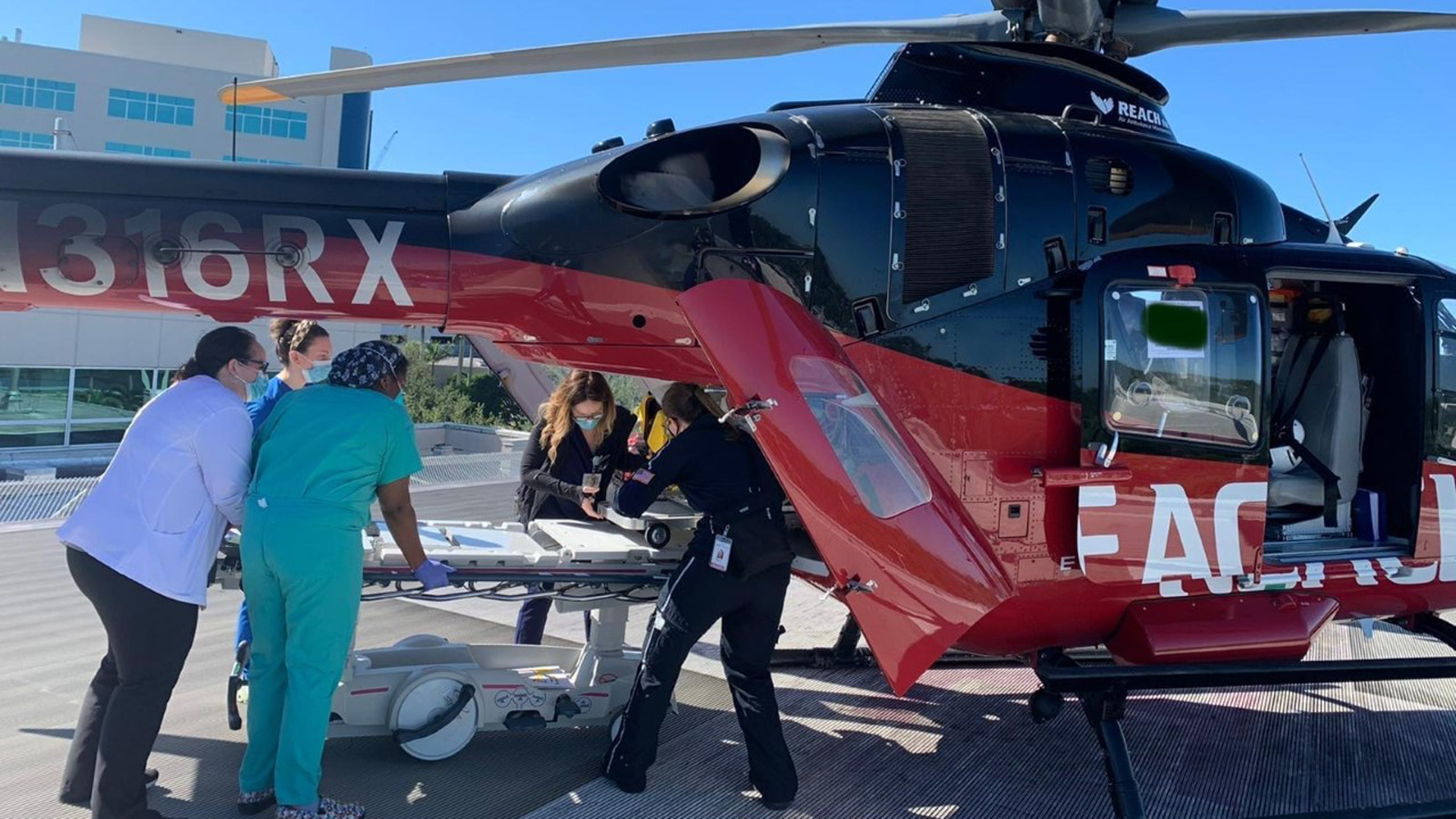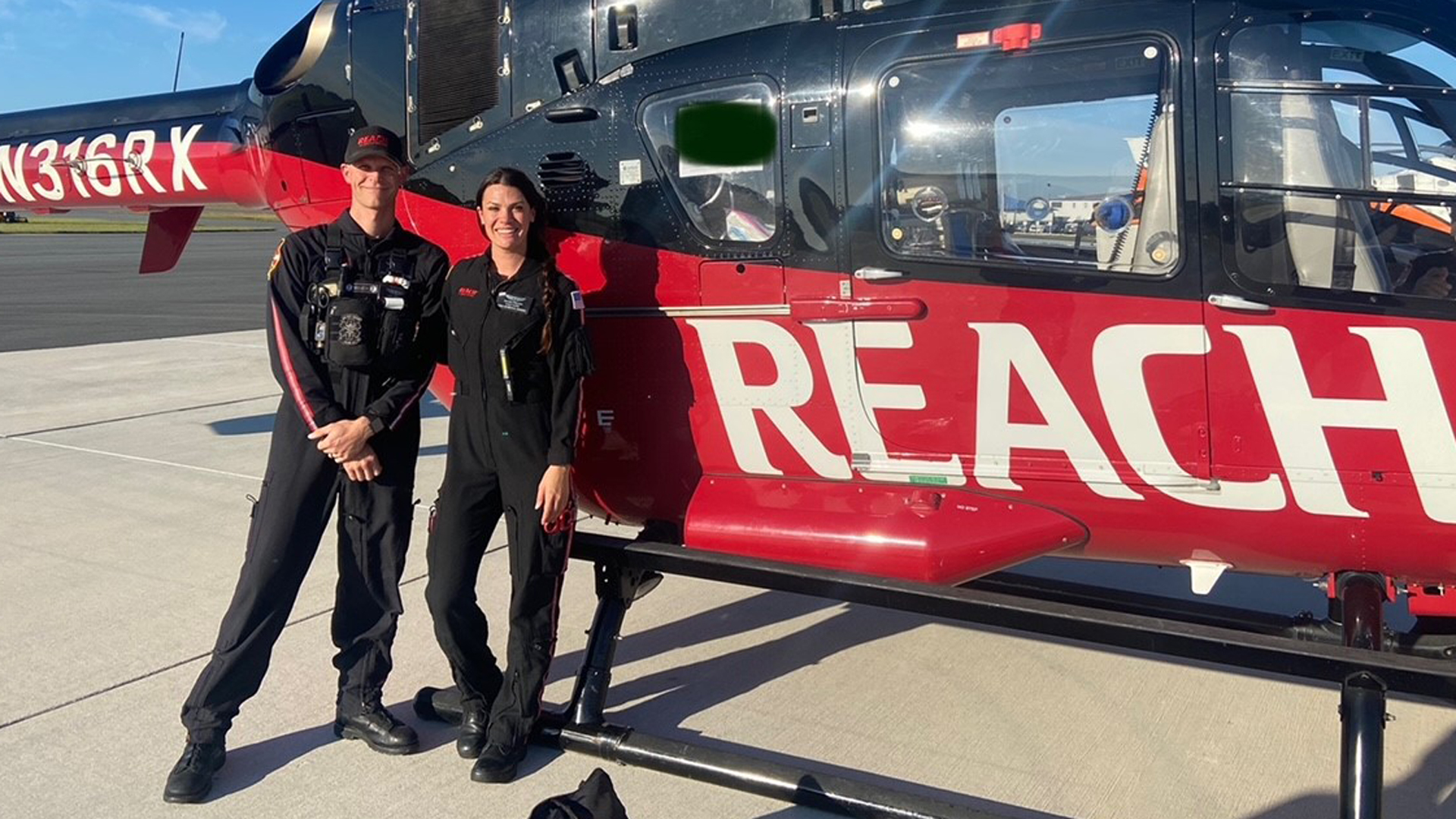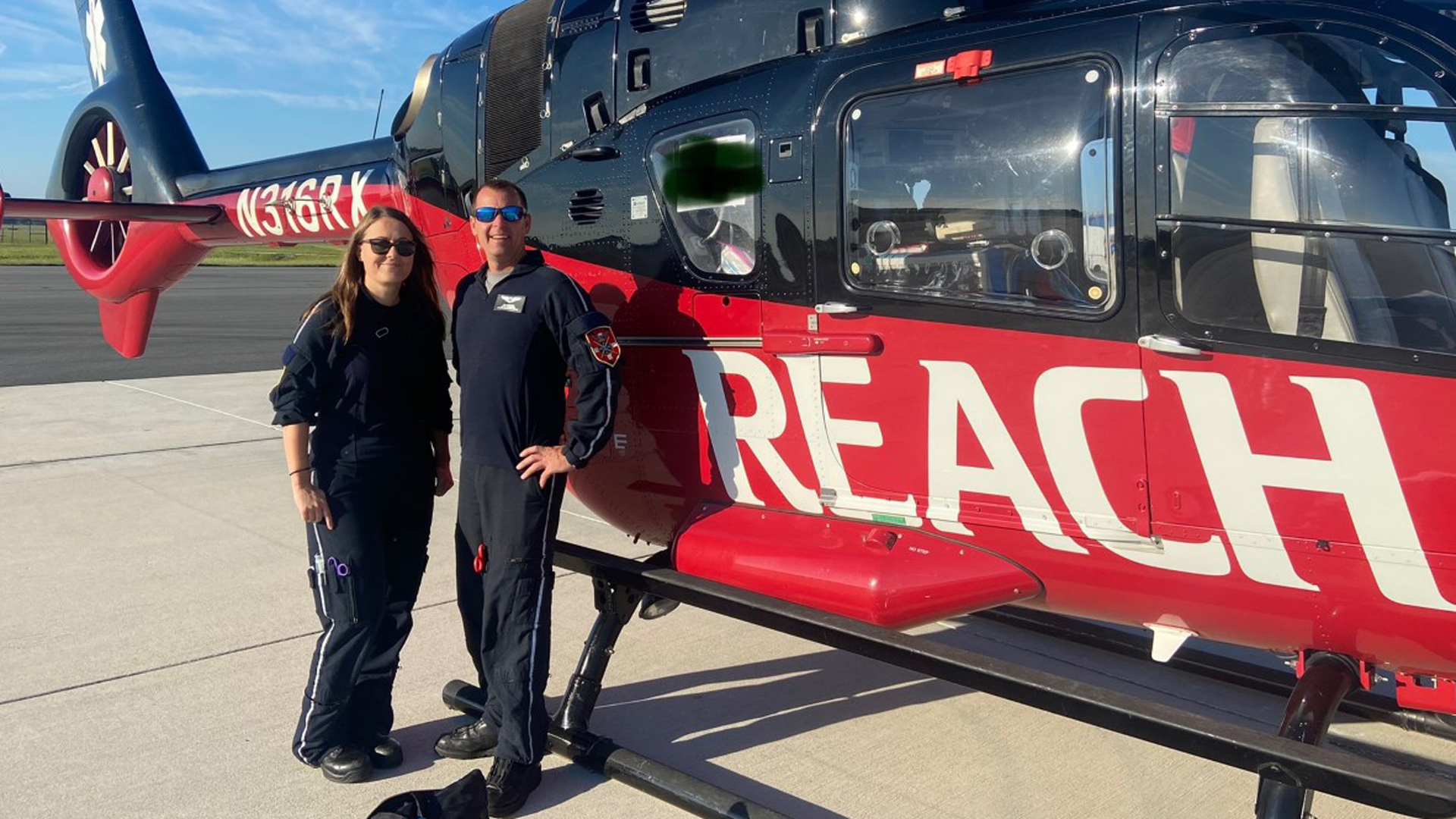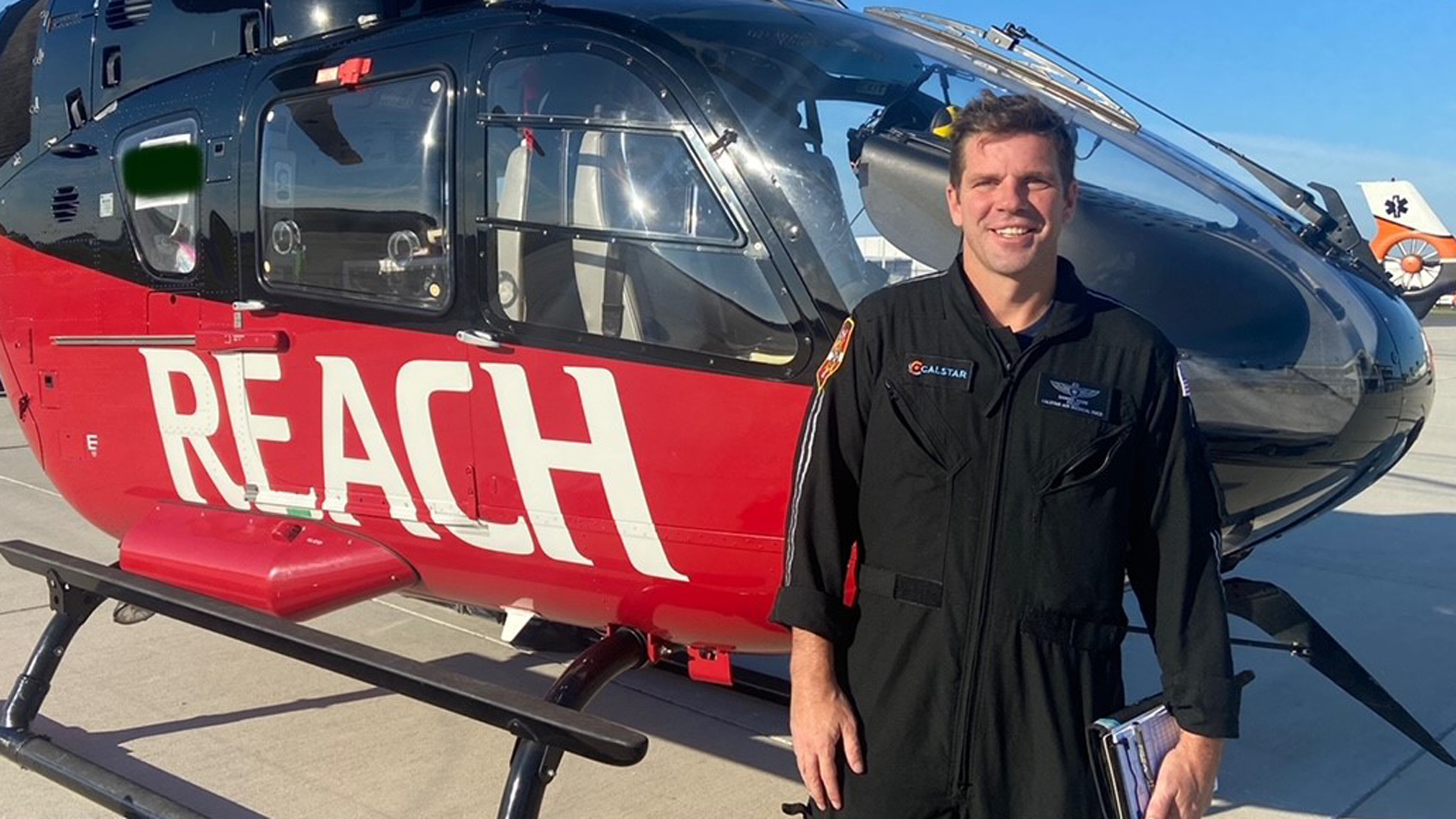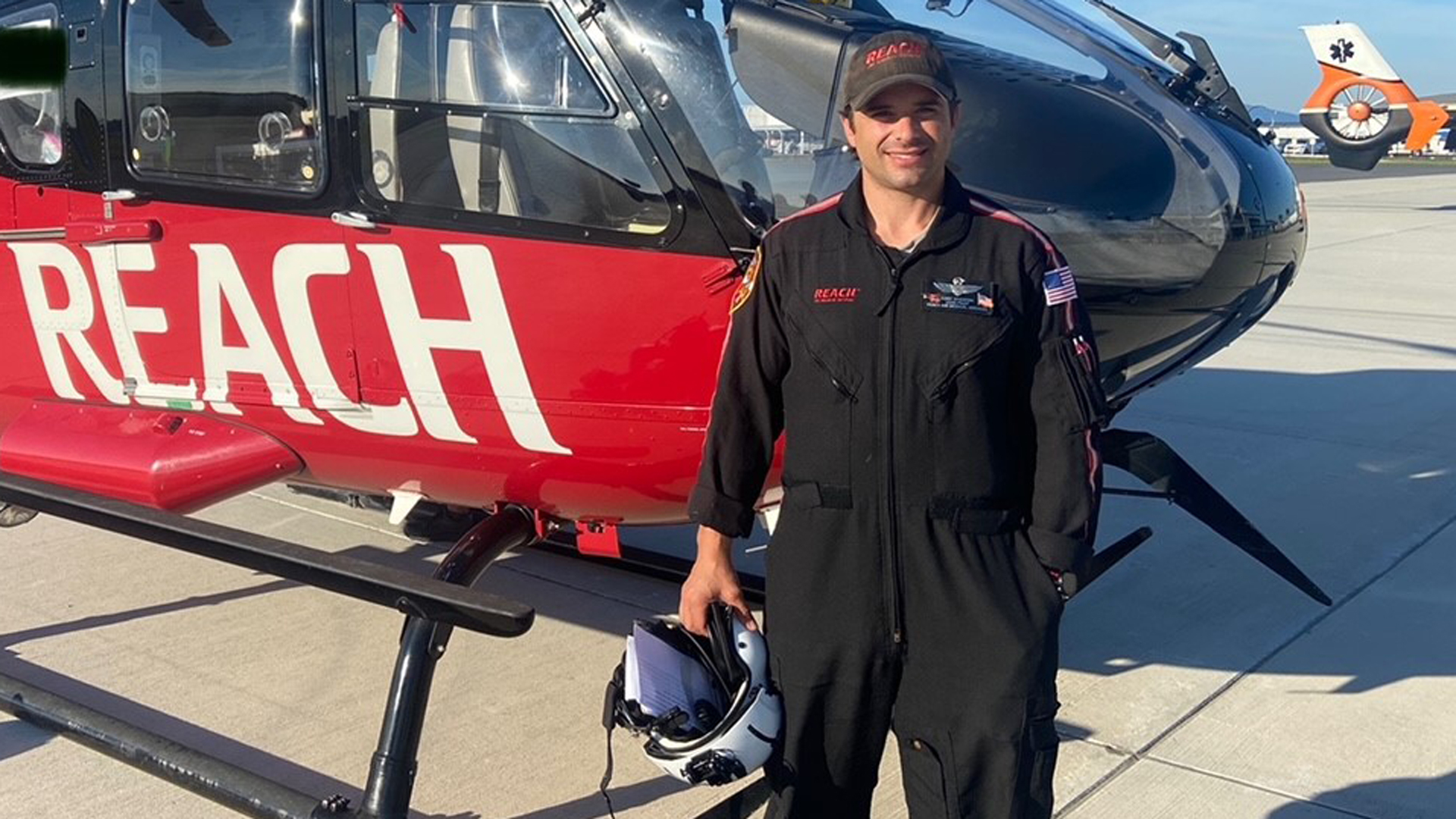48-Hours After the Storm
December 6, 2022
Neonatal teams from California help evacuate NICUs impacted by Hurricane Ian in Florida.
REACH Air Medical Services (REACH), one of the few air medical programs in the nation to have an independent specialty neonatal transport team, operates two air medical bases in Northern California capable of transporting such a specialized patient population.
Those two bases are over 3,000 miles from where Hurricane Ian was set to make landfall as a Category 4 hurricane on September 28, 2022. However, as the storm gathered strength in the Caribbean, REACH was preparing to send these highly trained first responders to help with what was predicted to be a tragic aftermath for the state of Florida.
Along with hundreds of other first responders, Neonatal Flight Nurses Diana Priego and Victoria England, Flight Paramedics Daniel Workman and Larry Cardwell and Pilots Daniel Kerr and Cody Wheaton were soon on their way to Northern Florida, where they would wait out Ian’s landfall.
All of the forecasts and predictions about the strength and storm surge of Ian were true. The Hurricane ravaged the coast of Southwest Florida and left a far-reaching path of destruction throughout Central Florida.
As soon as the weather conditions had improved enough for first responders to begin safely responding to requests for aid, the neonatal team from REACH and other air medical providers from Global Medical Response were relocated to the town of Punta Gorda.
Immediately upon landing, they had requests for transport. Since Kerr, Workman and Priego were assigned to dayshift, they were the first team to start transporting patients.
“We knew on our way down to Punta Gorda that some of the area hospitals had experienced flooding and were now without water,” said Priego. “So, we knew we needed to be prepared to respond to calls as soon as we arrived.”
Despite their best efforts to be prepared, the storm had knocked out electricity and internet service, so both Kerr and Wheaton had to rely on an untraditional method of flight planning.
“When we first arrived, there was no air traffic control to speak of,” said Wheaton. “At the altitudes we fly, none of the controlling centers with electricity could see and talk to us, so we were largely coordinating through air-to-air frequencies. A tethered drone gave us access to the internet at most locations, so we could look at imagery for the heliports we were going into, but we were relying mostly on crew coordination and reports from other assets in the area to determine the suitability of landing zones and locations of hazards.”
As one of the first helicopters to land at the area children’s hospital, they set off a chain of evacuation flights that would last nearly two days.
“When we arrived to transport our first patient out of the neonatal intensive care unit (NICU), the hospital had somewhere between 60 or 70 neonatal patients that they needed to evacuate,” said Priego. “By the time we arrived the next morning, nearly half of those patients had been transported out either by air or by ground ambulance, but this was when things just started to ramp up. They had already transported the critical patients out, but they needed to get the rest of these patients out as quickly and safely as possible.”
That day they helped to transport five NICU patients to hospitals throughout South Florida.
“We started our day at seven in the morning, and we didn’t arrive back to base until four the next morning,” said Workman. “We did great. We ran like a team should run, especially given the fact that all three of us were on new ground out here.”
While Workman, Priego and Kerr were busy running during the day, Cardwell, England and Wheaton were assigned to the night shift.
“Our first night, we transported one patient down to Fort Lauderdale,” said England. “What struck me most about that night was that despite the disaster and crisis conditions of the hospital, all the staff we interacted with were in incredibly high spirits. Many of these healthcare workers lost their homes, their cars were flooded in the hospital parking lot, they hadn't seen their families in days and were working in terribly difficult conditions, but they remained positive and focused only on the safety of their NICU babies.”
For the next 48-hours, REACH’s neonatal team worked tirelessly to help safely transport patients from impacted communities to NICUs throughout the state.
“When we took our last patient out on Thursday evening, they only had two babies left in the hospital,” said Priego. “They moved an average of 35 NICU patients a day, which is so impressive. The hospitals were very organized and had everything needed to transfer these babies prepared and ready to go.”
Weeks after the storm, when the cleanup and restoration process was well underway for the impacted communities of Southwestern Florida, the REACH neonatal team had yet another special deployment experience – taking the babies back to the sending NICUs.
“My favorite memory from this deployment was returning our patients back to the NICU they left in the days immediately following the storm,” said England. “It was a total full circle moment, and we were met with cheering nurses greeting us at the helipad, jumping up and down with excitement to see their favorite babies coming back to their care. I know how important that moment was to the babies' parents as well, since many were separated for those several weeks or were traveling hours to get to them. It was really touching to see the NICU back up and running and everyone back home where they belong. Overall, it was an incredible experience.”
Those two bases are over 3,000 miles from where Hurricane Ian was set to make landfall as a Category 4 hurricane on September 28, 2022. However, as the storm gathered strength in the Caribbean, REACH was preparing to send these highly trained first responders to help with what was predicted to be a tragic aftermath for the state of Florida.
Along with hundreds of other first responders, Neonatal Flight Nurses Diana Priego and Victoria England, Flight Paramedics Daniel Workman and Larry Cardwell and Pilots Daniel Kerr and Cody Wheaton were soon on their way to Northern Florida, where they would wait out Ian’s landfall.
All of the forecasts and predictions about the strength and storm surge of Ian were true. The Hurricane ravaged the coast of Southwest Florida and left a far-reaching path of destruction throughout Central Florida.
As soon as the weather conditions had improved enough for first responders to begin safely responding to requests for aid, the neonatal team from REACH and other air medical providers from Global Medical Response were relocated to the town of Punta Gorda.
Immediately upon landing, they had requests for transport. Since Kerr, Workman and Priego were assigned to dayshift, they were the first team to start transporting patients.
“We knew on our way down to Punta Gorda that some of the area hospitals had experienced flooding and were now without water,” said Priego. “So, we knew we needed to be prepared to respond to calls as soon as we arrived.”
Despite their best efforts to be prepared, the storm had knocked out electricity and internet service, so both Kerr and Wheaton had to rely on an untraditional method of flight planning.
“When we first arrived, there was no air traffic control to speak of,” said Wheaton. “At the altitudes we fly, none of the controlling centers with electricity could see and talk to us, so we were largely coordinating through air-to-air frequencies. A tethered drone gave us access to the internet at most locations, so we could look at imagery for the heliports we were going into, but we were relying mostly on crew coordination and reports from other assets in the area to determine the suitability of landing zones and locations of hazards.”
As one of the first helicopters to land at the area children’s hospital, they set off a chain of evacuation flights that would last nearly two days.
“When we arrived to transport our first patient out of the neonatal intensive care unit (NICU), the hospital had somewhere between 60 or 70 neonatal patients that they needed to evacuate,” said Priego. “By the time we arrived the next morning, nearly half of those patients had been transported out either by air or by ground ambulance, but this was when things just started to ramp up. They had already transported the critical patients out, but they needed to get the rest of these patients out as quickly and safely as possible.”
That day they helped to transport five NICU patients to hospitals throughout South Florida.
“We started our day at seven in the morning, and we didn’t arrive back to base until four the next morning,” said Workman. “We did great. We ran like a team should run, especially given the fact that all three of us were on new ground out here.”
While Workman, Priego and Kerr were busy running during the day, Cardwell, England and Wheaton were assigned to the night shift.
“Our first night, we transported one patient down to Fort Lauderdale,” said England. “What struck me most about that night was that despite the disaster and crisis conditions of the hospital, all the staff we interacted with were in incredibly high spirits. Many of these healthcare workers lost their homes, their cars were flooded in the hospital parking lot, they hadn't seen their families in days and were working in terribly difficult conditions, but they remained positive and focused only on the safety of their NICU babies.”
For the next 48-hours, REACH’s neonatal team worked tirelessly to help safely transport patients from impacted communities to NICUs throughout the state.
“When we took our last patient out on Thursday evening, they only had two babies left in the hospital,” said Priego. “They moved an average of 35 NICU patients a day, which is so impressive. The hospitals were very organized and had everything needed to transfer these babies prepared and ready to go.”
Weeks after the storm, when the cleanup and restoration process was well underway for the impacted communities of Southwestern Florida, the REACH neonatal team had yet another special deployment experience – taking the babies back to the sending NICUs.
“My favorite memory from this deployment was returning our patients back to the NICU they left in the days immediately following the storm,” said England. “It was a total full circle moment, and we were met with cheering nurses greeting us at the helipad, jumping up and down with excitement to see their favorite babies coming back to their care. I know how important that moment was to the babies' parents as well, since many were separated for those several weeks or were traveling hours to get to them. It was really touching to see the NICU back up and running and everyone back home where they belong. Overall, it was an incredible experience.”
